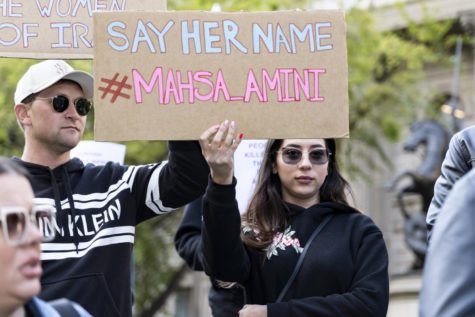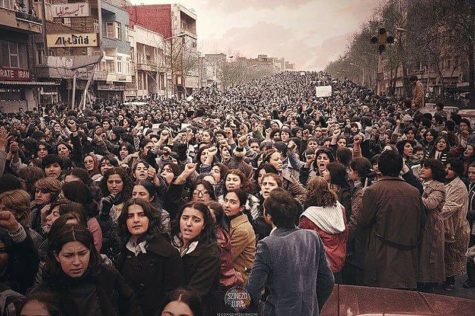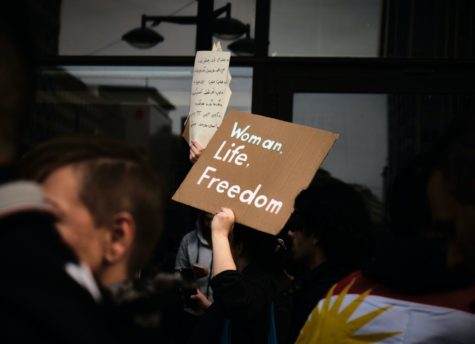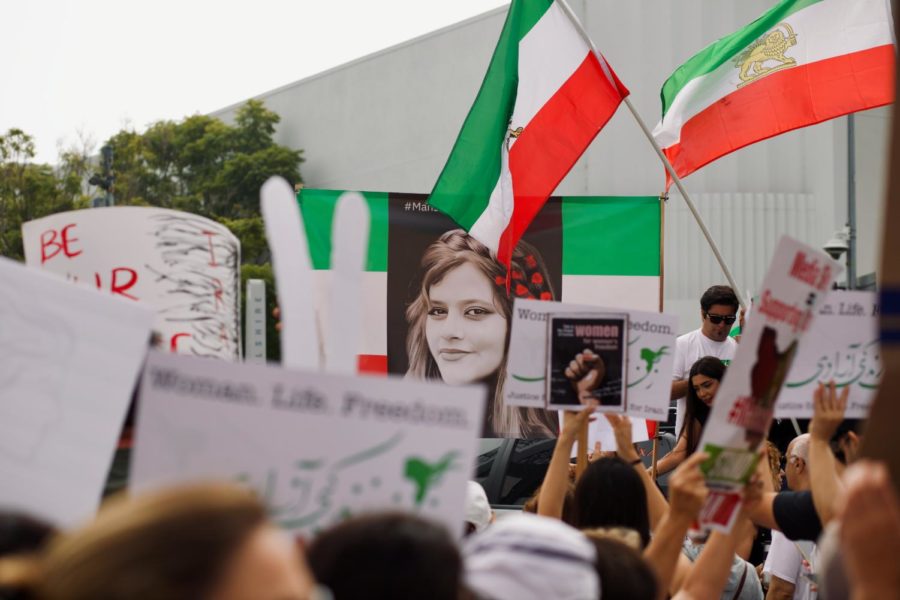Why Are People Protesting in Iran?
With at least two hundred protesters killed and thousands arrested since the protests began in September 2022, it is important to look at the causes of the unrest in Iran.
People gather in Santa Monica, California, to protest the death of Mahsa Amini. They hold an Iranian flag with Ms. Amini’s photo at the center.
On September 13th, 2022, Mahsa (Jina) Amini, a 22-year-old Kurdish woman, was visiting Tehran, the capital city of Iran, with her family, when she was stopped by members of Iran’s morality police. They detained her on the grounds that she was not ‘properly dressed’ and was wearing ‘improper hijab.’ Her death in police custody a few days later has sparked anger among Iranians, many of whom have taken to the streets across the country to express their outrage.
While authorities have stated that her death was due to a heart attack, eyewitnesses have reported that she was beaten by the morality police. Ms. Amini’s family has also stated that she was healthy. These protests have been spearheaded by women, who have been removing and sometimes burning their headscarves, which women must wear in public. They have also cut their hair, along with chanting and marching together in protest of the restrictive laws. These acts of defiance have not gone unpunished: at least two hundred protesters have been killed so far, and thousands have been arrested. Yet, punishment hasn’t deterred the protestors from continuing to march. Shadi Sadr, an Iranian lawyer and human rights advocate, told The New York Times, “[the protestors] are standing up and saying, ‘Enough of this. I am willing to die to have a life worth living.’”
Iran’s morality police are a part of the Iranian Law Enforcement Forces. They were officially established after the Islamic Revolution in 1979, and their job is to enforce the dress code laws pertaining to modesty; If they see someone violating these laws, they may detain them and take them to “re-education centers,” where they are lectured on the importance of modesty. Many Iranian women have had encounters with the morality police, which is, in part, what has helped to fuel the outrage of these protests.
Iranian authorities have restricted access to the internet in certain areas of the country, citing security reasons. This blockage has included certain websites in an effort to curtail the protests, such as Instagram and WhatsApp. These apps were used to help spread awareness about the protests. The United States has expanded Iran’s internet access to support the protest efforts and ensure that the Iranian people have access to unbiased, trustworthy information.
On September 21st, 2022, President Joe Biden told the U.N. General Assembly, “We stand with the brave citizens and the brave women of Iran who right now are demonstrating to secure their basic rights.”
The U.S. is not alone in showing solidarity with the protesters. In major European cities such as Istanbul, Paris, and Stockholm, people have taken to the streets, with some protesters even shaving their heads or cutting their hair. In Los Angeles, a city with a large Iranian population, thousands gathered to protest. Many vigils have been held, including one in front of the White House, to show support for the protesters.

Many government officials have condemned Ms. Amini’s death. They have also urged the Iranian government to conduct a full investigation into the cause of Ms. Amini’s death, which President Ebrahim Raisi has promised will happen.
The U.S. Department of the Treasury has also placed sanctions on Iran’s morality police and senior security officials. In a statement, the Secretary of the Treasury, Janet L. Yellen said, “Today’s action to sanction Iran’s Morality Police and senior Iranian security officials responsible for this oppression demonstrates the Biden – Harris Administration’s clear commitment to stand up for human rights, and the rights of women, in Iran and globally.”
These protests aren’t the first ones that have occurred in Iran. Ever since the Islamic Revolution in 1979 that overthrew the Shah, many events have culminated in a change in leadership. Protests have become more common in the country over time, even more so in the past few years.
Before the Revolution, reasonable progress had been made concerning women’s rights. Upon opening in 1936, Tehran University permitted both men and women to study there. In 1963, women finally gained the right to vote in Iran. The age of marriage for girls was raised from 13 to 18 (which has since been lowered back to 13), and women could petition for divorce and child custody.
Despite these feats, the women’s rights movement still struggled in Iran. From 1936 to 1941, veils were banned under Reza Shah Pahlavi. He introduced this measure in an attempt to westernize and modernize Iran, as well as advance women’s rights. Yet, his actions alienated many women who believed that it should be an individual’s choice whether or not to wear the veil. The Shah was overthrown in 1941, which promptly ended the ban on the veil.
After the Islamic Revolution and the introduction of Ayatollah Khomeini as Supreme Leader of Iran, women’s rights were restricted, leading to many protests. When the possibility of a law forcing women to wear the hijab in public arose, it was met with much resistance from women who chose to wear the hijab, as well as those who did not.
On International Women’s Day in 1979, thousands of Iranian women protested against the potential law. They marched in the streets together, chanting, “We didn’t have a revolution to go backwards.”

In response, the government stated that it was solely a recommendation, not law. However, laws were soon introduced that undermined the progress made in women’s rights in Iran. The change crept in slowly: it started with gender segregation in public areas and laws favoring men in cases of divorce, child custody, and inheritance. Eventually, in 1983, it became required for women in Iran above the age of puberty to observe hijab.
More recently, since 2017, people have been protesting poor economic conditions, the government, and inflation, among other issues. In fact, the recent protests in Iran have expanded to be more directed at frustration with the Iranian government rather than singular grievances.
Inflation is high throughout the world, and Iran has been no exception. With an inflation rate continuing to rise, many Iranians are struggling to afford basic necessities. High inflation rates have been observed in food products, especially fruits, vegetables, and meat. The percentage of households in Iran that were prone to food insecurity rose sharply from 2017 to 2019.
Shervin Hajipour, an Iranian singer, wrote and released the song “Baraye” on September 28th, 2022. ‘Baraye,’ which means ‘because of,’ addresses the challenges of life in Iran. The lyrics reflect issues such as gender discrimination, censorship, oppressive laws, and poverty. The song quickly gained popularity after Hajipour posted it on his Instagram account. However, Hajipour was arrested and forced to take down “Baraye” soon after. He has since been released on bail and posted a statement on Instagram (that has been deleted) emphasizing his love for Iran and rejection of “Baraye” being used for political reasons outside of Iran. Some suspect that he was forced to write the statement.

There is doubt over whether these protests will lead to meaningful change in Iran. While some think that they won’t, citing previous anti-government protests that have taken place in Iran, others are more optimistic. The recent protests seem to be different from other ones for a number of reasons. Tara Sepehri Far, a researcher in the Middle East and North Africa division of Human Rights Watch, said, “This one feels very scattered, and across ethnic divide in a way that is, again, different. There’s a new connectivity.”
Shadi Sadr, an Iranian lawyer and human rights advocate, told The New York Times, “[the protestors] are standing up and saying, ‘Enough of this. I am willing to die to have a life worth living.’”
Marissa Talushllari is a Copy Chief for ‘The Science Survey.' She likes journalistic writing because it is a way of informing the public about important...











